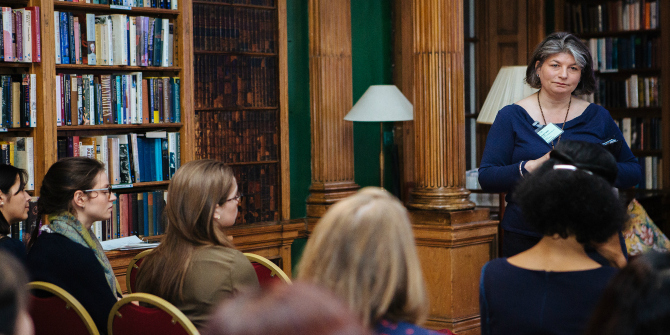
 Gender differences in scholarly productivity have proved a persistent problem. But to what extent is the situation improving for younger generations of female academics? Ulf Sandström and Peter van den Besselaar report on research showing that overall productivity for female researchers is about two thirds of male productivity, a ratio that had actually already been established by the end of the 1960s and has remained stable ever since. Gender influences female researchers’ academic rank, role in research teams and networks, and likelihood of being awarded funding. This then has a negative effect on their productivity, which in turn reinforces their lower status and position. This vicious circle means career differences will not simply diminish over time.
Gender differences in scholarly productivity have proved a persistent problem. But to what extent is the situation improving for younger generations of female academics? Ulf Sandström and Peter van den Besselaar report on research showing that overall productivity for female researchers is about two thirds of male productivity, a ratio that had actually already been established by the end of the 1960s and has remained stable ever since. Gender influences female researchers’ academic rank, role in research teams and networks, and likelihood of being awarded funding. This then has a negative effect on their productivity, which in turn reinforces their lower status and position. This vicious circle means career differences will not simply diminish over time.
The productivity puzzle – gender differences in scholarly productivity – is a persistent problem (Xie 1999). Even if some studies suggest that the situation has improved for younger generations of female academics, the gender productivity gap is still disproportionately high. According to our calculations the difference between male and female productivity is still the same as it was in the 1960s, despite increasing female participation in science. This contradicts the oft-proposed hypothesis that women will automatically “catch up” with their male colleagues (European Commission 2015).
For citation impact the situation is different, as female researchers tend to have a similar impact to equally productive male researchers. However, the condition “equally productive” is crucial, as in the higher productivity classes men are strongly overrepresented and the propensity to have highly cited papers is higher in these high-productivity classes. Therefore, productivity is of crucial importance for your chances of having well-recognised papers. Those who publish many papers also publish more highly cited papers. Together this leads to a lower overall productivity for female researchers, which, according to our data, is about two thirds of male productivity – a ratio that had already been established by the end of the 1960s and, consequently, seems to have remained stable over time, with nothing pointing towards a change of this phenomenon. And the same holds for overall impact.
In order to discover the factors leading to the productivity gap, we used a dataset covering the total Swedish population of publishing authors. From the population of 47,000, we extracted a subset of almost 7,000 researchers at ten of the larger Swedish universities during the period 2008‑2011. In addition to productivity and impact data, for this subset we also collected data on the researchers’ age, institutional position, and position in the research team. Our findings indicate that gender productivity differences are explained by three factors:
- Men occupy higher institutional positions, and those in higher positions are more productive, and this holds when the population is broken down into age groups.
- Female researchers have fewer last-author positions (typically reserved for the group leader) than men do, which reflects that women typically occupy lower positions within research teams and are less often (considered as) leaders of a team or a collaboration network.
- Male researchers’ careers progress at a faster rate than their female counterparts’.
These factors explain half of the productivity difference.
In other words, what we observe is a vicious circle, which may explain the persistence of a glass-ceiling effect in science: gender stereotyping influences the academic rank of women, their position in research collaborations and in teams, and the lower speed of their careers. These factors in turn have an effect on productivity, which may reciprocally influence career, academic rank, and the team role of female researchers, and may also reinforce gender stereotyping. As said, the factors mentioned explain 50 % of performance differences, but other important factors need to be taken into account too, such as grant success and international mobility.
 Figure 1: Relation between grants, performance, career and gender. This figure is an adaptation of that which appears in the authors’ article, “Vicious circles of gender bias, lower positions, and lower performance: Gender differences in scholarly productivity and impact”, published in PLoS ONE.
Figure 1: Relation between grants, performance, career and gender. This figure is an adaptation of that which appears in the authors’ article, “Vicious circles of gender bias, lower positions, and lower performance: Gender differences in scholarly productivity and impact”, published in PLoS ONE.
There are many studies suggesting there is gender bias in grant allocation, and if women are provided with fewer resources, one may expect a negative effect on careers and positions (as these depend on receiving prestigious grants). In an era of internationalisation of science, the importance of international experience for academic careers is expected to increase, but access to mobility is expected to be different for men and women.
All this suggests the sustained productivity differences can be explained by several factors that seem to disadvantage female researchers, denying them equal opportunities to develop into top productive researchers. Given this, gender stereotyping will prove to be resilient and the performance and career differences will not simply diminish over time, as the underlying factors reinforce each other. Instead, gender equality policies remain important to break the vicious circles that produce the glass ceiling for women in science.
This blog post is based on the authors’ article, “Vicious circles of gender bias, lower positions, and lower performance: Gender differences in scholarly productivity and impact”, published in PLoS ONE (DOI: 10.1371/journal.pone.0183301), and on related work.
Featured image credit: Mohdammed Ali, via Unsplash (licensed under a CC0 1.0 license).
Note: This article gives the views of the authors, and not the position of the LSE Impact Blog, nor of the London School of Economics. Please review our comments policy if you have any concerns on posting a comment below.
About the authors
Ulf Sandström is Senior Lecturer at Linköping University and affiliated researcher at KTH Royal Institute of Technology in Stockholm. Currently he is working with the Gedii-team studying gender diversity in research teams. He focuses on questions related to research policy, often with bibliometric methods. Some of his latest reports and articles can be found at the forskningspolitik website.
Peter van den Besselaar is professor of organisation sciences at the Vrije Universiteit Amsterdam, the Netherlands, Faculty of Social Sciences, and research director at Teresa Mom Consultancy, Amsterdam, the Netherlands. His research focuses on the organisation, governance, and dynamics of science. In recent years, he has been engaged in an interdisciplinary team developing the SMS platform, an infrastructure for integration and enrichment of heterogeneous data, and in the GendERC project, studying gender bias in grant allocation.








“Our findings indicate that gender productivity differences are explained by three factors:
Men occupy higher institutional positions, and those in higher positions are more productive, and this holds when the population is broken down into age groups.
Female researchers have fewer last-author positions (typically reserved for the group leader) than men do, which reflects that women typically occupy lower positions within research teams and are less often (considered as) leaders of a team or a collaboration network.
Male researchers’ careers progress at a faster rate than their female counterparts’.
These factors explain half of the productivity difference”
How much of these three factors is due to wrongful discrimination? Did I miss the part where you show that, here? (You seem to just jump to “unequal opportunity.”) How does this relate to stereotype accuracy, where people are rather accurate about sex differences and where they do individualize, given personal information?.
Did you consider the posibility that your choice of indicators was itself strikingly gender-biased and elite-biased? Are leadership, last authorship, and number of publications really the best indicators of ‘productivity’? Are you perhaps infantilising female academics by assuming they are all desperately seeking the kinds of academic prestige you happen to value, but are passive victims of a male conspiracy? Might most actually be intelligently pursuing different goals than you pursue? Perhaps they are more ‘productive’ in teaching and in workplace sociability? Perhaps they are better pursuers of work-life harmony? (n.b. these are just questions I feel you should consider before making any more pronouncements about gender bias. I don’t know the answers).